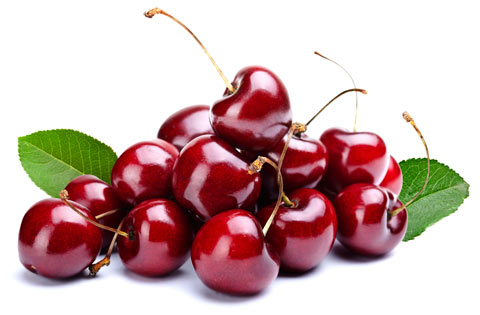Cancer-Fighting Compounds in Cherries

Fun Facts:
In Traverse City, Michigan calls itself the Cherry Capital of the World and has an annual National Cherry Festival every July that attracts thousands of visitors from around the world. (i.52)
Cherries are a delicious natural source of melatonin — the natural antioxidant hormone some medical experts refer to as the "magic molecule" because of its many health benefits — including anticancer effects. (i.61)
The cherry (Prunus serotina) is categorized as a drupe, which means it is an edible fruit that contains a single stone pit. Though cherries do not contain as many vitamins and minerals as other fruits in the same family, both types (sweet and sour) do contain numerous compounds that have been shown to fight cancer and other ailments. (i.1, 4, 52)
Native to Europe and Asia and named after an ancient town in Turkey, cherries were brought to the United States by the early settlers and are enormously popular in America. Although Europe produces most of the commercially grown cherries in the world, the northwestern United States accounts for over 156,000 tons a year of sweet cherries, and about 100,000 tons of sour cherries grown mostly in the U.S. state of Michigan. (i.52)
Cherry fruit is a rich source of anthocyanin flavonoids, such as quercetin, and melatonin, a natural antioxidant hormone, as well as numerous other nutritious and delicious cancer-fighting compounds. In addition to the fruit, the stalks and resin from cherry trees have long been used as natural folk remedies for different ailments. These parts of the cherry tree, along with the leaves and seeds, also contain compounds that form cyanide, a poisonous substance. Some experts suggest that the level of cyanide may actually prove to be effective against cancer cells. However, the powerful antioxidants and nutrients in the delicious and edible portions of cherries have been shown to have antitumor effects in a number of different cancers, without the potential risk of cyanide. (i.52, 54)
Nutritional Content
Although there are nutritional differences between sweet and sour varieties of cherries on a group level (e.g., the phytosterols in sweet cherries are not found in sour types), both pack impressive levels of important nutrients in addition to potent phytochemical flavonoids: (i.57)
| CHERRY | ||
|---|---|---|
| NUTRIENT | SWEET (RAW) | SOUR (RAW) |
| Calories |
91.35 calories/serving |
77.5 calories |
| Protein | 1.54 g | 1.55 g |
| Sugars | 18.59 g | 13.16 g |
| Fiber | 3.01 g | 2.48 g |
| Phytosterols | 17.4 mg | --- |
| Beta carotene | 55.1 mcg | 1193.5 mcg |
| Calcium | 18.85 mg | 24.8 mg |
| Folate | 5.8 mcg | 12.4 mcg |
| Glutamic acid | 0.12 g | --- |
| Iron | 0.52 mg | 0.50 mg |
| Lutein & Zeaxanthin | 123.25 mcg | 131.75 mcg |
| Magnesium | 15.95 mg | 13.95mg |
| Manganese | 0.10 mg | 0.17 mg |
| Niacin | 0.22 mg | 0.62 mg |
| Potassium | 321.9 mg | 268.15 mg |
| Vitamin A | 92.8 IU | 1988.65 IU |
|
Vitamin B5 |
0.29 mg | 0.22 mg |
| Vitamin C | 10.15 mg | 15.5 mg |
|
Vitamin E |
0.18 mg |
0.11 |
| Zinc | 0.10 mg | 0.16 mg |
Evidence of Cancer-Fighting Benefits
Cherries contain multiple phytochemicals known to have anticancer properties. These include:
-
Anthocyanin flavonoids. Two types of beneficial compounds that cherries contain are flavonoids found in the deep anthocyanin pigments that give cherries their characteristic purplish-red hue — anthocyanidins and proanthocyanidins. These powerful antioxidants have been shown to protect cells from free radical damage, are natural anti-inflammatory pain relievers, and are thought to lower the risk for many types of cancer. (i.5, 52)
In fact, cherry's ability to inhibit the inflammatory COX-1 and COX-2 inflammatory enzymes is comparable to NSAIDs such as ibuprofen and naproxen, and without the potentially serious side effects of COX-2 inhibiting drugs such as Vioxx® and Celebrex®. And cherry anthocyanidins exert strong antioxidant activity against free radicals than even vitamin E. (i.52)
- Ellagic acid. Another antioxidant compound in cherries, ellagic acid has been found to help stop carcinogens from turning healthy cells into cancer cells. (i.4)
- Perillyl alcohol. Lab and animal research indicates that perillyl alcohol has powerful antitumor effects against all types of cancer, including advanced breast, prostate, and ovarian carcinomas. It's believed to inhibit cancer cell growth by blocking production of proteins that tumors need to grow. In animal studies perillyl alcohol was able to reduce breast cancer tumors by up to 75% in advanced malignancies and over 80% in smaller tumors. (i.52)
- Amygdalin. May reduce tumor growth and size. (i.1)
-
Melatonin. Tart cherries also contains significant amounts of this powerful antioxidant hormone which acts as an anti-inflammatory pain reliever and also helps regulate sleep cycles. Melatonin is produced by the body in darkness, and its levels can be reduced by artificial light and life schedules that lead to unnatural sleep patterns. Low levels of melatonin are associated with increased risk of cancer, and dietary intake of melatonin may help boost melatonin level. (i.5)
Research demonstrates that melatonin also protects DNA from damage, helps regulate cellular function, boosts the immune system, and promotes production of the body's own natural antioxidant enzymes. Melatonin helps regulate hormones and hormone receptors — important in the development of many diseases, including cancer. Studies suggest that melatonin's antidepressant effects may help cancer patients undergoing chemotherapy as well. (i.61)
A study with tart cherries found that they were beneficial in stopping cell damage related to carcinogenic chemicals found in charred meat. Cherries also contain fiber, which may help reduce the risk of colon cancer. (i.1, 5)
Adding Cherries to Your Diet
Fortunately frozen cherries contain nearly the same nutritional value as those that are fresh. Dried cherries do not contain as many beneficial nutrients as fresh cherries, but they are a healthy alternative if fresh or frozen cherries are not available. Cherry juice that is 100 percent pure and not-from-concentrate also provides beneficial nutrients. (i.2)
Choosing and Storing Cherries
Fresh sweet cherries are only available in the summer months, but they can be frozen for up to 10 months. The most popular type grown commercially in the United States is the Bing cherry, a large variety with deep red flesh and skin so dark burgundy in color it appears almost black when ripe. The Rainier variety, a crossbreed of the Bing and Van types, is much lighter in color with a yellow-pink skin, and is even sweeter than the Bing cherry. The best way to freeze cherries is to first freeze them spread out on a cookie sheet (without the stems) and then transfer to a freezer bag. (i.1, 52)
Sour cherries are smaller and softer than the sweet varieties and are usually not eaten fresh. However, the over 270 varieties of tart cherries are easy to can and freeze and make for great pies. (i.52)
Growing Cherries in a Home Garden
Cherry trees can be grown reliably in zones 5 to 8, and are typically plagued by the same types of pests found in apple trees. Birds tend to poach the fruit of sweet cherries more than tart, but most growers find it helpful to cover both with a net. (i.11)
Cherries will not ripen once picked, so they should be harvested only when ripe and the fruits should be unblemished and uniform in color. (i.1)



